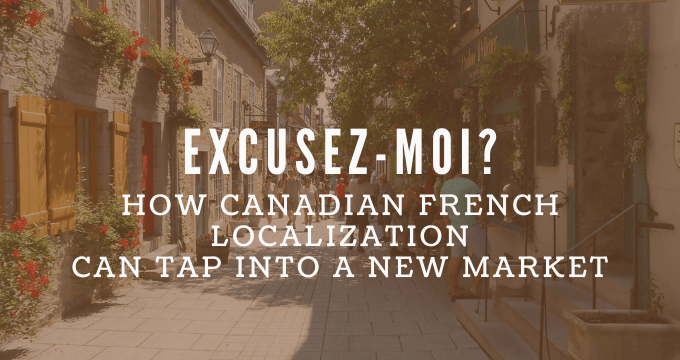Within Canada, there are 11 recognized official languages, with English and French being the two official languages of the country. While English is used by 57% of the population, 21% of the remaining speak French Canadian. To explore the importance of localizing your European French content to Canadian French, we spoke to the head of our French Canadian team Annie Estéphan, author of the book ‘Les canadianismes français’, and a passionate linguist. Annie has worked in English, Spanish and Canadian French translation services since 2005, specializing in the fields of Corporate Communications, Healthcare, and Information Technology, and has a lot to say on the importance of localizing your French content to effectively capture the French Canadian market.
To Understand Our Present We Must First Understand Our Past.
French Canadian emerged in the mid-century when French king; Francis I, landed in Gaspé Peninsula, North America, in 1534 – establishing ‘New France’. The settlers brought with them French culture, French customs, and the French Language. The Industrial revolution saw Canada grow a close relationship with the United States, and over time French-speaking Canadians began adopting English words into their version of French.
The Unlocal Locals
Annie explains, being a minority in Canada, but a majority in the province of Quebec, (about 7 million people), French Canadians don’t feel Canadian in the same way English speakers of Canada do. However, French Canadians don’t feel European French either.
As such, when something sounds like a bad English translation, French Canadians are offended, and when something sounds like a European translation with weird expressions or punctuation, French Canadians are also offended.
Bilingual Canadians will switch to the English version instead of reading a European French version or a bad translation, while French Canadians who don’t speak English, (which is the majority of the big province of Quebec), would read the French version, and not hesitate to write to the company saying that Canada is not France, and that they are offended by this.
French Canadians are passionate about their language and cultural differences, and this has always been a hot topic in Canada, with Quebecers making multiple unsuccessful referendums for independence from Canada.
Non-Localized Legal Issues
Today the French-Canadian language is legally protected in Quebec by the Charter of the French Language of 1977, a law that was passed at the height of a nationalist, separatist movement in Quebec. English usage on public signs, for example, is severely limited. Today, Quebec French, or Québécois, is the primary language in Quebec, Ontario, and New Brunswick.
Since the adoption of this bill, Canadian French has been adopted in labor, commerce, administration and education. This means that in the province of Quebec, businesses are not allowed to work in English. Bill 101 prohibits francophone students (Canadians and immigrants) from attending anglophone primary and secondary schools unless their parents or grandparents studied in English before Bill 101 was passed.
Bill 101 also prohibits putting up signs or ads in English, even bilingual ones, meaning you will see everything written only in French, and it’s hard to be served in English outside of big cities like Montreal.
Fr Fr v Canadian Fr – The Basic differences
- Pronunciation
The pronunciation of Canadian French and European French is completely different. Canadian French sounds more like the ancient popular European French, like when Jacques Cartier came to Canada in the early 16th century. But, of course, it has evolved a lot during the centuries, especially with industrialization and recent technology.
- Grammar
The grammar is practically the same; however, in European French, they put spaces before the punctuation marks and do not put accents on capital letters.
- Anglicisms
Since French is a minority in Canada, but a majority in the province of Quebec, French Canadians tend to be protectionist about their language. Anglicisms are not tolerated in writing, however, it’s another story when spoken. In European French, English words are used on a daily basis (email, sponsor, fax, smartphone, home cinema), however in Quebec, these words are translated into Canadian French, (courriel, commanditaire, télécopieur, téléphone intelligent, cinéma maison).
- Vocabulary
Occasionally in European French, they use French words that do not have the same meaning for French Canadians. An example of this is ‘glace’ (ice cream in Europe) translates to ‘ice’ in Canada, and French Canadians use ‘crème glacée’. ‘Parfum’ in Europe means ‘perfume’, and in Canada, they would say ‘saveur’.
A classic example of a translation gone awry in Annie’s experience is when she was working on a survey. She says “Once I was localizing an informal survey from gamers from European French to Canadian French, and they asked: Combien de gosses as-tu? (How many testicles do you have?).
In European French ‘gosses’ is an informal way to say ‘children’, but in Canada, it only means ‘testicles’.”
At Language Department, we have in-country French Canadian translators and linguists to help you navigate localizing content for the Canadian market.
Avoid the ‘faux pas’ and ‘excuser moi’ with our expert linguists.
Want to learn more about our marketing localization services? Head here.




